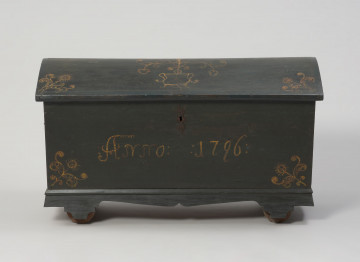
Table clock
1701 — 1800
National Museum in Lublin
Part of the collection: Clocks (17th–1st half of the 19th c.)
The need to measure time more accurately, taking into account not only the passing months and days, but also the hours and minutes, emerged with the development of civilisation. However, sundials, water clocks and candlestick clocks were used before the hands that we know so well today began to tell time.
It was not until the 1850s that mantel clocks appeared in France, quickly becoming an obligatory accessory in palaces and houses belonging to the aristocracy and wealthy bourgeoisie throughout Europe. In addition, timepieces, being a combination of art and craftsmanship, were usually made from luxurious materials, and thus not everyone could afford them. Rich ornamentation and numerous gildings made the clocks not only tell time, but also serve a decorative function.
The clock from the collection of the National Museum in Lublin has a case made of black-polished wood with gilded figural elements. On the pedestal there is a full-plastic figure of a kneeling angel, holding in his raised hands a drum-shaped clock case with a round dial shielded by a convex glass in a metal frame. At the top of the clock there is a figure of Cupid feeding a bird as clock artists often referred in their works to the transience of time, putting vanitas motifs in their decorations, for example referring to the blissful time spent. For timepieces were a symbol of the transience of life, and their ticking was identified with the inevitable arrival of death: "the clock is ticking, the world is sugar-coating its dignities - oh, how many have already failed its hypocrisies" (Kancyonał i kantyczka czyli zbiór najnowszych pieśni na cały rok z novenną i na adwent. [The Hymnal and Canticle - a Collection of the Newest Songs for the Whole Year with Novenna and for Advent. For the Spiritual Consolation and Benefit of Pious People. Newly revised and corrected], Wadowice 1889).
Author / creator
Dimensions
cały obiekt: height: 28 cm, width: 47 cm
Object type
goldsmith's art
Technique
French polish coating
Material
wood, bronze, brass, steel, glass
Creation time / dating
Creation / finding place
Owner
The National Museum in Lublin
Identification number
Location / status

1701 — 1800
National Museum in Lublin

1780 — 1790
National Museum in Lublin

1796
National Museum in Szczecin
DISCOVER this TOPIC
National Museum in Lublin
DISCOVER this PATH
Educational path